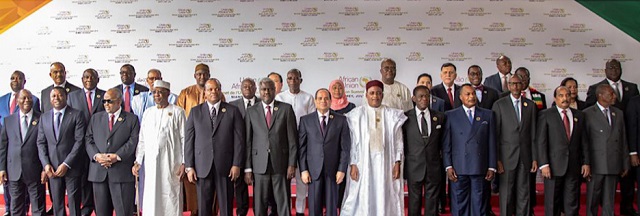
Economists say significant challenges remain, including poor road and rail links, excessive border bureaucracy and petty corruption
| THE INDEPENDENT | On July. 07, African nations officially unveiled a landmark trade agreement at the African Union Summit in Niamey, Niger, with the long sought-after agreement hailed as a historic step towards “peace and prosperity” across the continent.
After 17 years of tough negotiations, the AU unveiled the “operational phase” of the African Continental Free Trade Area (AfCFTA) in what AU commission chairman Moussa Faki had described as a “historic” moment.
“An old dream is coming true, the founding fathers must be proud,” said Faki, adding that AfCFTA would create “the greatest trading area in the world”.
Niger’s President Mahamadou Issoufou hailed it as “the greatest historical event for the African continent since the creation of the Organisation of African Unity in 1963,” referring to the AU’s predecessor.
AU officials announced the launch of the five “operational instruments” of the African Continental Free Trade Area (AfCFTA).
Nations agreed to shared “rules of origin, the monitoring and elimination of non-tariff barriers, a unified digital payments system and an African trade observatory dashboard”, the AU commission announced.
The agreement was given a boost when the presidents of Nigeria and Benin appended their signatures onto the continental’s trade deal early in the morning at the two-day summit.
With Nigeria and Benin on board, 54 of the 55 AU member countries have now signed onto the deal, with holdout Eritrea announcing it will consider joining the pact.
Around 4,500 delegates and guests — including 32 heads of state and more than 100 ministers – attended the AU summit in Niamey, which has been revamped and boasts a brand-new airport, upgraded roads, and new hotels for the occasion.
‘Game changer for Africa’
The agreement was formalised at the end of April when the agreement crossed the launch threshold, which required ratification by at least 22 countries.
The zone will be operational from July.01, 2020, giving countries time to adapt to the agreed changes, Issoufou said.
Malawi’s director of trade, Christina Chatima, told AFP the trade agreement as a “game changer for Africa.”
“Most of us export with Europe and the US. It’s about time we started trading more with each other,” she said.
However despite the launch, there are still key issues leaders have yet to resolve. Leaders could not agree on a common criteria for rules of origin for some sectors.
“An agreement has not yet been reached on some of these issues,” Chatima said. “On textiles, even the automotive sector. The AU secretariat is meant to come up with proposals on how we can agree,” she added.
The AfCFTA commits the majority of countries to 90 percent tariff cuts within a five year period — reducing barriers to trade on the continent.
Countries on a United Nations list of ‘Least Developed Countries’ will have 10 years to cut tariffs, whilst a group of six countries – including Niger and Malawi – will have at least 15 years, Chatima said.
 The Independent Uganda: You get the Truth we Pay the Price
The Independent Uganda: You get the Truth we Pay the Price



